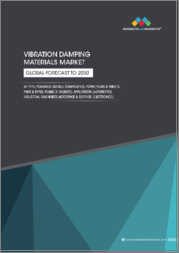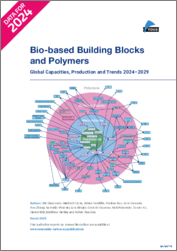
|
시장보고서
상품코드
1303508
셀룰로오스계 폴리머 시장 : 세계 산업 분석, 규모, 점유율, 성장률, 동향, 예측(2023-2030년)Cellulosic Polymers Market - Global Industry Analysis, Size, Share, Growth, Trends, and Forecast 2023-2030 |
||||||
셀룰로오스계 폴리머는 의약품, 텍스타일, 식품 및 음료, 석유 및 가스, 건축, 종이·펄프 등 다양한 산업에서 폭넓은 용도를 찾아내고 있습니다. 셀룰로오스계 폴리머가 제공하는 다양한 용도와 바람직한 특성에 의해 세계의 셀룰로오스계 폴리머 시장은 큰 성장을 달성하고 있습니다.
세계의 셀룰로오스계 폴리머 시장을 조사했으며, 시장 개요, 시장 영향요인 분석, 관련 법규제, 기술 동향, 생산 통계, 시장 규모의 추이·예측, 각종 구분·지역별 상세 분석, 경쟁 구도, 주요 기업의 개요 등을 정리하여 전해드립니다.
목차
제1장 주요 요약
- 세계의 셀룰로오스계 폴리머 시장 스냅숏
- 주요 시장 동향
- 향후 예측
- 애널리스트에 의한 제안
제2장 시장 개요
- 시장의 정의·세분화
- 시장 역학
- 촉진요인
- 억제요인
- 시장 기회 매트릭스
- 밸류체인 분석
- Porter's Five Forces 분석
- COVID-19의 영향 분석
- 기술 상황
- 주요 규제
- 경제 분석
- PESTLE
제3장 세계의 셀룰로오스계 폴리머 시장 : 생산 통계
- 주요 하이라이트
- 지역별 생산량 분석
- 북미
- 유럽
- 아시아태평양
- 기타 지역
제4장 셀룰로오스계 폴리머의 가격 동향 분석
- 주요 하이라이트
- 가격에 영향을 미치는 주요 요인
- 제품별 가격
- 지역별 가격
제5장 세계의 셀룰로오스계 폴리머 시장 전망
- 세계의 셀룰로오스계 폴리머 시장 전망 : 제품별
- 주요 하이라이트
- 세계의 셀룰로오스계 폴리머 시장 전망 : 용도별
- 주요 하이라이트
- 세계의 셀룰로오스계 폴리머 시장 전망 : 지역별
- 주요 하이라이트
- BPS 분석·시장의 매력 분석
제6장 북미의 셀룰로오스계 폴리머 시장 전망
제7장 유럽의 셀룰로오스계 폴리머 시장 전망
제8장 아시아태평양의 셀룰로오스계 폴리머 시장 전망
제9장 라틴아메리카의 셀룰로오스계 폴리머 시장 전망
제10장 중동 및 아프리카의 셀룰로오스계 폴리머 시장 전망
제11장 경쟁 구도
- 기업의 시장 점유율 분석
- 경쟁 대시보드
- 기업 개요
- Nouryon
- CP Kelco
- Ashland Inc.
- Shin-Etsu Chemical
- Celanese
- The Dow Chemical Company
- International Flavors & Fragrances Inc.
- Lotte Fine Chemical
- Eastman Chemical
- Daicel Corporation
- Nagase & CO., LTD.
- Mitsubishi Chemical Corporation
- Celotech Chemical Co., Ltd.
- Rotuba
제12장 부록
KSA 23.07.13Cellulose, an abundant organic polymer found in plants, algae, and bacteria, exhibits biodegradable and biocompatible properties. Cellulosic polymers find extensive applications across various industries, including pharmaceuticals, textiles, food and beverages, oil and gas, construction, and pulp and paper. The global cellulosic polymers market is experiencing significant growth due to the diverse range of applications and desirable properties offered by these polymers.
Growing Usage in Ophthalmic Drug Development Drives Market Momentum:
Cellulosic polymers are widely used in the healthcare and pharmaceutical industry, particularly in ophthalmic formulations. Research and development initiatives have demonstrated the safety and effectiveness of cellulose polymers in ocular drug delivery for both animals and humans. The nanocomposites derived from cellulose have shown superior results compared to other polymers, making them a promising platform for ocular drug discovery. This application in the pharmaceutical industry is expected to drive strong growth in the global cellulosic polymers market.
Thriving Textile Industry Boosts Market Growth:
Cellulosic polymers possess functional properties that make them an excellent raw material for the textile industry. Clothing products made from regenerated cellulosic polymers exhibit exceptional washability, absorbency, smoothness, softness, and comfort. These properties have expanded the application range of regenerated cellulosic polymers in various textile products, including apparel, home textiles, and knitted wear. The growing demand for specific types of regenerated cellulosic polymers like cupro and lyocell further contributes to the sustained growth of the cellulosic polymers market.
Asia Pacific Leads the Cellulosic Polymers Market:
Asia Pacific holds a prominent position in the global cellulosic polymers market due to favorable macroeconomic factors and the presence of major end-use industries. The region benefits from sustained economic growth, a significant customer base, and the concentration of key companies in various sectors. Additionally, the cigarette manufacturing industry in China and India, which utilizes cellulose esters, has contributed to Asia Pacific's leading market position. Factors such as rising GDP per capita and population growth further drive the demand for cellulosic polymers in the region.
Leading Market Players:
Key players in the global cellulosic polymers market include: Daicel Corporation, DuPont, Mitsubishi Chemical Holdings Corporation, Celanese Corporation, Xinjiang Zhongtai Chemical Co. Ltd., Eastman Chemical Corporation, Celotech Chemical Co., Ashland, Nouryon, J. M. Huber Corporation, LENZING AG, Grasim, Sappi, China National Tobacco Corporation, and Acordis Cellulosic Polymers. These companies actively contribute to the market's growth through innovation and product development in the field of cellulosic polymers.
Table of Contents
1. Executive Summary
- 1.1. Global Cellulosic Polymers Market Snapshot
- 1.2. Key Market Trends
- 1.3. Future Projections
- 1.4. Analyst Recommendations
2. Market Overview
- 2.1. Market Definitions and Segmentations
- 2.2. Market Dynamics
- 2.2.1. Drivers
- 2.2.1.1. Driver A
- 2.2.1.2. Driver B
- 2.2.1.3. Driver C
- 2.2.2. Restraints
- 2.2.2.1. Restraint 1
- 2.2.2.2. Restraint 2
- 2.2.3. Market Opportunities Matrix
- 2.2.1. Drivers
- 2.3. Value Chain Analysis
- 2.4. Porter's Five Forces Analysis
- 2.5. Covid-19 Impact Analysis
- 2.5.1. Pre-covid and Post-covid Scenario
- 2.5.2. Supply Impact
- 2.5.3. Demand Impact
- 2.6. Technology Landscape
- 2.7. Key Regulations
- 2.7.1. FDA Regulations
- 2.7.2. Import/Export Regulations
- 2.8. Economic Analysis
- 2.9. PESTLE
3. Global Cellulosic Polymers Market, Production Statistics
- 3.1. Key Highlights
- 3.2. Production Output Analysis, by region
- 3.2.1. North America
- 3.2.2. Europe
- 3.2.3. Asia Pacific
- 3.2.4. Rest of the World
4. Cellulosic Polymers Price Trend Analysis, 2019 - 2030
- 4.1. Key Highlights
- 4.2. Key Factors Affecting the Price
- 4.3. Price by Product
- 4.4. Prices by Region
5. Global Cellulosic Polymers Market Outlook, 2019 - 2030
- 5.1. Global Cellulosic Polymers Market Outlook, by Product, Volume (Tons) and Value (US$ Mn), 2019 - 2030
- 5.1.1. Key Highlights
- 5.1.1.1. Cellulose Esters
- 5.1.1.1.1. Cellulose Acetate
- 5.1.1.1.2. Cellulose Acetate-Propionate
- 5.1.1.1.3. Cellulose Acetate-Butyrate
- 5.1.1.1.4. Misc.
- 5.1.1.2. Cellulose Ethers
- 5.1.1.2.1. Carboxymethyl Cellulose (CMC)
- 5.1.1.2.2. Methyl Cellulose & Derivatives
- 5.1.1.2.3. Hydroxyethyl Cellulose & Derivatives
- 5.1.1.2.4. Ethyl Cellulose
- 5.1.1.2.5. Misc.
- 5.1.1.3. Nitrocellulose
- 5.1.1.4. Regenerated Cellulose
- 5.1.1.5. Misc.
- 5.1.1.1. Cellulose Esters
- 5.1.1. Key Highlights
- 5.2. Global Cellulosic Polymers Market Outlook, by Application, Volume (Tons) and Value (US$ Mn), 2019 - 2030
- 5.2.1. Key Highlights
- 5.2.1.1. Food & Beverage
- 5.2.1.2. Building Materials
- 5.2.1.3. Oilfield
- 5.2.1.4. Pharmaceuticals
- 5.2.1.5. Personal Care
- 5.2.1.6. Pulp & Paper
- 5.2.1.7. Textiles
- 5.2.1.8. Cigarette Filter Tow
- 5.2.1.9. Paints & Coatings
- 5.2.1.10. Misc. (Consumer Goods, etc.)
- 5.2.1. Key Highlights
- 5.3. Global Cellulosic Polymers Market Outlook, by Region, Volume (Tons) and Value (US$ Mn), 2019 - 2030
- 5.3.1. Key Highlights
- 5.3.1.1. North America
- 5.3.1.2. Europe
- 5.3.1.3. Asia Pacific
- 5.3.1.4. Latin America
- 5.3.1.5. Middle East & Africa
- 5.3.2. BPS Analysis/Market Attractiveness Analysis
- 5.3.1. Key Highlights
6. North America Cellulosic Polymers Market Outlook, 2019 - 2030
- 6.1. North America Cellulosic Polymers Market Outlook, by Product, Volume (Tons) and Value (US$ Mn), 2019 - 2030
- 6.1.1. Key Highlights
- 6.1.1.1. Cellulose Esters
- 6.1.1.1.1. Cellulose Acetate
- 6.1.1.1.2. Cellulose Acetate-Propionate
- 6.1.1.1.3. Cellulose Acetate-Butyrate
- 6.1.1.1.4. Misc.
- 6.1.1.2. Cellulose Ethers
- 6.1.1.2.1. Carboxymethyl Cellulose (CMC)
- 6.1.1.2.2. Methyl Cellulose & Derivatives
- 6.1.1.2.3. Hydroxyethyl Cellulose & Derivatives
- 6.1.1.2.4. Ethyl Cellulose
- 6.1.1.2.5. Misc.
- 6.1.1.3. Nitrocellulose
- 6.1.1.4. Regenerated Cellulose
- 6.1.1.5. Misc.
- 6.1.1.1. Cellulose Esters
- 6.1.1. Key Highlights
- 6.2. North America Cellulosic Polymers Market Outlook, by Application, Volume (Tons) and Value (US$ Mn), 2019 - 2030
- 6.2.1. Key Highlights
- 6.2.1.1. Food & Beverage
- 6.2.1.2. Building Materials
- 6.2.1.3. Oilfield
- 6.2.1.4. Pharmaceuticals
- 6.2.1.5. Personal Care
- 6.2.1.6. Pulp & Paper
- 6.2.1.7. Textiles
- 6.2.1.8. Cigarette Filter Tow
- 6.2.1.9. Paints & Coatings
- 6.2.1.10. Misc. (Consumer Goods, etc.)
- 6.2.1. Key Highlights
- 6.3. North America Cellulosic Polymers Market Outlook, by Country, Volume (Tons) and Value (US$ Mn), 2019 - 2030
- 6.3.1. Key Highlights
- 6.3.1.1. U.S.
- 6.3.1.2. Canada
- 6.3.2. BPS Analysis/Market Attractiveness Analysis
- 6.3.1. Key Highlights
7. Europe Cellulosic Polymers Market Outlook, 2019 - 2030
- 7.1. Europe Cellulosic Polymers Market Outlook, by Product, Volume (Tons) and Value (US$ Mn), 2019 - 2030
- 7.1.1. Key Highlights
- 7.1.1.1. Cellulose Esters
- 7.1.1.1.1. Cellulose Acetate
- 7.1.1.1.2. Cellulose Acetate-Propionate
- 7.1.1.1.3. Cellulose Acetate-Butyrate
- 7.1.1.1.4. Misc.
- 7.1.1.2. Cellulose Ethers
- 7.1.1.2.1. Carboxymethyl Cellulose (CMC)
- 7.1.1.2.2. Methyl Cellulose & Derivatives
- 7.1.1.2.3. Hydroxyethyl Cellulose & Derivatives
- 7.1.1.2.4. Ethyl Cellulose
- 7.1.1.2.5. Misc.
- 7.1.1.3. Nitrocellulose
- 7.1.1.4. Regenerated Cellulose
- 7.1.1.5. Misc.
- 7.1.1.1. Cellulose Esters
- 7.1.1. Key Highlights
- 7.2. Europe Cellulosic Polymers Market Outlook, by Application, Volume (Tons) and Value (US$ Mn), 2019 - 2030
- 7.2.1. Key Highlights
- 7.2.1.1. Food & Beverage
- 7.2.1.2. Building Materials
- 7.2.1.3. Oilfield
- 7.2.1.4. Pharmaceuticals
- 7.2.1.5. Personal Care
- 7.2.1.6. Pulp & Paper
- 7.2.1.7. Textiles
- 7.2.1.8. Cigarette Filter Tow
- 7.2.1.9. Paints & Coatings
- 7.2.1.10. Misc. (Consumer Goods, etc.)
- 7.2.1. Key Highlights
- 7.3. Europe Cellulosic Polymers Market Outlook, by Country, Volume (Tons) and Value (US$ Mn), 2019 - 2030
- 7.3.1. Key Highlights
- 7.3.1.1. Germany
- 7.3.1.2. France
- 7.3.1.3. U.K.
- 7.3.1.4. Italy
- 7.3.1.5. Spain
- 7.3.1.6. Russia
- 7.3.1.7. Rest of Europe
- 7.3.2. BPS Analysis/Market Attractiveness Analysis
- 7.3.1. Key Highlights
8. Asia Pacific Cellulosic Polymers Market Outlook, 2019 - 2030
- 8.1. Asia Pacific Cellulosic Polymers Market Outlook, by Product, Volume (Tons) and Value (US$ Mn), 2019 - 2030
- 8.1.1. Key Highlights
- 8.1.1.1. Cellulose Esters
- 8.1.1.1.1. Cellulose Acetate
- 8.1.1.1.2. Cellulose Acetate-Propionate
- 8.1.1.1.3. Cellulose Acetate-Butyrate
- 8.1.1.1.4. Misc.
- 8.1.1.2. Cellulose Ethers
- 8.1.1.2.1. Carboxymethyl Cellulose (CMC)
- 8.1.1.2.2. Methyl Cellulose & Derivatives
- 8.1.1.2.3. Hydroxyethyl Cellulose & Derivatives
- 8.1.1.2.4. Ethyl Cellulose
- 8.1.1.2.5. Misc.
- 8.1.1.3. Nitrocellulose
- 8.1.1.4. Regenerated Cellulose
- 8.1.1.5. Misc.
- 8.1.1.1. Cellulose Esters
- 8.1.1. Key Highlights
- 8.2. Asia Pacific Cellulosic Polymers Market Outlook, by Application, Volume (Tons) and Value (US$ Mn), 2019 - 2030
- 8.2.1. Key Highlights
- 8.2.1.1. Food & Beverage
- 8.2.1.2. Building Materials
- 8.2.1.3. Oilfield
- 8.2.1.4. Pharmaceuticals
- 8.2.1.5. Personal Care
- 8.2.1.6. Pulp & Paper
- 8.2.1.7. Textiles
- 8.2.1.8. Cigarette Filter Tow
- 8.2.1.9. Paints & Coatings
- 8.2.1.10. Misc. (Consumer Goods, etc.)
- 8.2.1. Key Highlights
- 8.3. Asia Pacific Cellulosic Polymers Market Outlook, by Country, Volume (Tons) and Value (US$ Mn), 2019 - 2030
- 8.3.1. Key Highlights
- 8.3.1.1. China
- 8.3.1.2. Japan
- 8.3.1.3. South Korea
- 8.3.1.4. India
- 8.3.1.5. Southeast Asia
- 8.3.1.6. Rest of Asia Pacific
- 8.3.2. BPS Analysis/Market Attractiveness Analysis
- 8.3.1. Key Highlights
9. Latin America Cellulosic Polymers Market Outlook, 2019 - 2030
- 9.1. Latin America Cellulosic Polymers Market Outlook, by Product, Volume (Tons) and Value (US$ Mn), 2019 - 2030
- 9.1.1. Key Highlights
- 9.1.1.1. Cellulose Esters
- 9.1.1.1.1. Cellulose Acetate
- 9.1.1.1.2. Cellulose Acetate-Propionate
- 9.1.1.1.3. Cellulose Acetate-Butyrate
- 9.1.1.1.4. Misc.
- 9.1.1.2. Cellulose Ethers
- 9.1.1.2.1. Carboxymethyl Cellulose (CMC)
- 9.1.1.2.2. Methyl Cellulose & Derivatives
- 9.1.1.2.3. Hydroxyethyl Cellulose & Derivatives
- 9.1.1.2.4. Ethyl Cellulose
- 9.1.1.2.5. Misc.
- 9.1.1.3. Nitrocellulose
- 9.1.1.4. Regenerated Cellulose
- 9.1.1.5. Misc.
- 9.1.1.1. Cellulose Esters
- 9.1.1. Key Highlights
- 9.2. Latin America Cellulosic Polymers Market Outlook, by Application, Volume (Tons) and Value (US$ Mn), 2019 - 2030
- 9.2.1. Key Highlights
- 9.2.1.1. Food & Beverage
- 9.2.1.2. Building Materials
- 9.2.1.3. Oilfield
- 9.2.1.4. Pharmaceuticals
- 9.2.1.5. Personal Care
- 9.2.1.6. Pulp & Paper
- 9.2.1.7. Textiles
- 9.2.1.8. Cigarette Filter Tow
- 9.2.1.9. Paints & Coatings
- 9.2.1.10. Misc. (Consumer Goods, etc.)
- 9.2.1. Key Highlights
- 9.3. Latin America Cellulosic Polymers Market Outlook, by Country, Volume (Tons) and Value (US$ Mn), 2019 - 2030
- 9.3.1. Key Highlights
- 9.3.1.1. Brazil
- 9.3.1.2. Mexico
- 9.3.1.3. Rest of Latin America
- 9.3.2. BPS Analysis/Market Attractiveness Analysis
- 9.3.1. Key Highlights
10. Middle East & Africa Cellulosic Polymers Market Outlook, 2019 - 2030
- 10.1. Middle East & Africa Cellulosic Polymers Market Outlook, by Product, Volume (Tons) and Value (US$ Mn), 2019 - 2030
- 10.1.1. Key Highlights
- 10.1.1.1. Cellulose Esters
- 10.1.1.1.1. Cellulose Acetate
- 10.1.1.1.2. Cellulose Acetate-Propionate
- 10.1.1.1.3. Cellulose Acetate-Butyrate
- 10.1.1.1.4. Misc.
- 10.1.1.2. Cellulose Ethers
- 10.1.1.2.1. Carboxymethyl Cellulose (CMC)
- 10.1.1.2.2. Methyl Cellulose & Derivatives
- 10.1.1.2.3. Hydroxyethyl Cellulose & Derivatives
- 10.1.1.2.4. Ethyl Cellulose
- 10.1.1.2.5. Misc.
- 10.1.1.3. Nitrocellulose
- 10.1.1.4. Regenerated Cellulose
- 10.1.1.5. Misc.
- 10.1.1.1. Cellulose Esters
- 10.1.1. Key Highlights
- 10.2. Middle East & Africa Cellulosic Polymers Market Outlook, by Application, Volume (Tons) and Value (US$ Mn), 2019 - 2030
- 10.2.1. Key Highlights
- 10.2.1.1. Food & Beverage
- 10.2.1.2. Building Materials
- 10.2.1.3. Oilfield
- 10.2.1.4. Pharmaceuticals
- 10.2.1.5. Personal Care
- 10.2.1.6. Pulp & Paper
- 10.2.1.7. Textiles
- 10.2.1.8. Cigarette Filter Tow
- 10.2.1.9. Paints & Coatings
- 10.2.1.10. Misc. (Consumer Goods, etc.)
- 10.2.1. Key Highlights
- 10.3. Middle East & Africa Cellulosic Polymers Market Outlook, by Country, Volume (Tons) and Value (US$ Mn), 2019 - 2030
- 10.3.1. Key Highlights
- 10.3.1.1. GCC
- 10.3.1.2. South Africa
- 10.3.1.3. Rest of Middle East & Africa
- 10.3.2. BPS Analysis/Market Attractiveness Analysis
- 10.3.1. Key Highlights
11. Competitive Landscape
- 11.1. Company Market Share Analysis, 2022
- 11.2. Competitive Dashboard
- 11.3. Company Profiles
- 11.3.1. Nouryon
- 11.3.1.1. Company Overview
- 11.3.1.2. Product Portfolio
- 11.3.1.3. Financial Overview
- 11.3.1.4. Business Strategies and Development
- 11.3.2. CP Kelco
- 11.3.3. Ashland Inc.
- 11.3.4. Shin-Etsu Chemical
- 11.3.5. Celanese
- 11.3.6. The Dow Chemical Company
- 11.3.7. International Flavors & Fragrances Inc.
- 11.3.8. Lotte Fine Chemical
- 11.3.9. Eastman Chemical
- 11.3.10. Daicel Corporation
- 11.3.11. Nagase & CO., LTD.
- 11.3.12. Mitsubishi Chemical Corporation
- 11.3.13. Celotech Chemical Co., Ltd.
- 11.3.14. Rotuba
- 11.3.1. Nouryon
12. Appendix
- 12.1. Research Methodology
- 12.2. Report Assumptions
- 12.3. Acronyms and Abbreviations



















